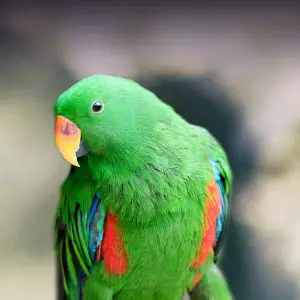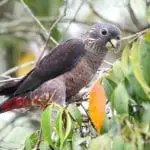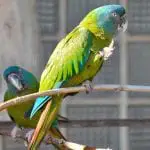Scientific Facts
| Common Name: | Eclectus Parrot |
| Scientific Name: | Eclectus roratus |
| Life Span: | Up to 50 years |
| Size: | Medium |
| Length: | 12 to 14.5 inches |
| Weight: | 388 to 524 grams |
| Habitat: | Rainforests |
| Country of Origin: | Australia, Indonesia, Papua New Guinea, and the Solomon Islands |
Physical Description
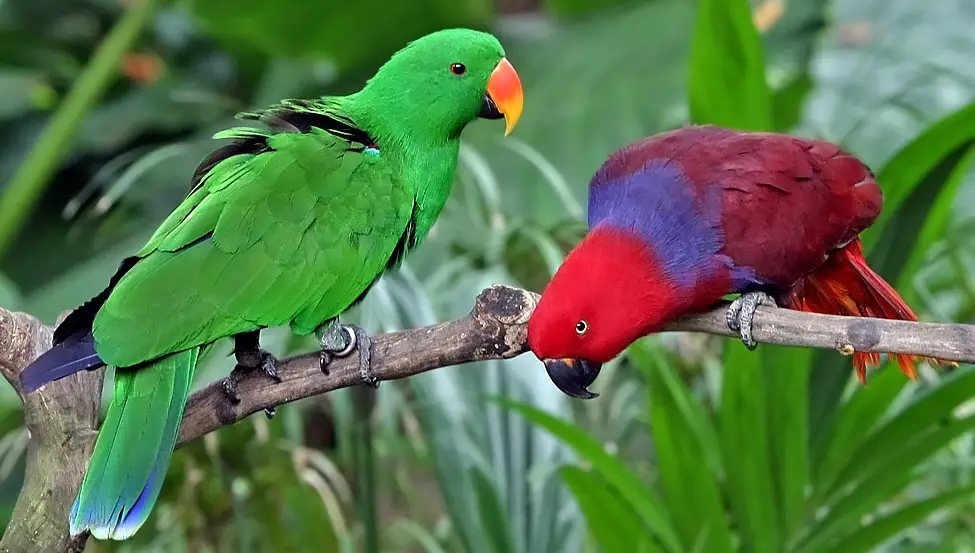
The Eclectus parrots are bright, colorful birds that look that they are straight out of a children’s book. Their feathers are so fluffy and smooth that they look so much like fur. For females, their colors are bright red, but for males, they are colored green with a candy corn looking beak. Aside from their unique appearance, the Eclectus parrots are also known for being a great companion pet for humans.
The most famous markings of these birds are their feathers. Because, instead of distinct lines that are carried by most birds, their feathers look like fur that has blended well together. When they are paired with their extremely vivid color, it looks almost as if these birds were painted on. But, even if these colors can be so bright, they actually work well to camouflage the Eclectus parrots in their natural habitat.
Eclectus parrots are dimorphic in nature, which basically means that there are significant differences between the two sexes. The females, who are colored red, also come with a black beak and a violet belly. The females have a blue-colored collar across the mantle, and their underwings and bend of the wings are also colored with bright blue. Their tails are tipped with an orange color.
On the other hand, the males who are primarily green have a splash of bright blue on their wings and red colors in their underwings. The males have a tail that is square and is quite short with the feathers in the center colored with green ending in blue tips. The outer tail feathers are blue with white tips, while the underside of the tails is yellow with a dusky tip. Their upper mandibles are coral pink, but the lower mandible is usually black. The toes and feet are gray in color.
Because of these differences, the Eclectus parrots were not bred for many years because the breeders thought that they were different species. They attempted to breed the males with each other and the females with the same gender.
Subspecies
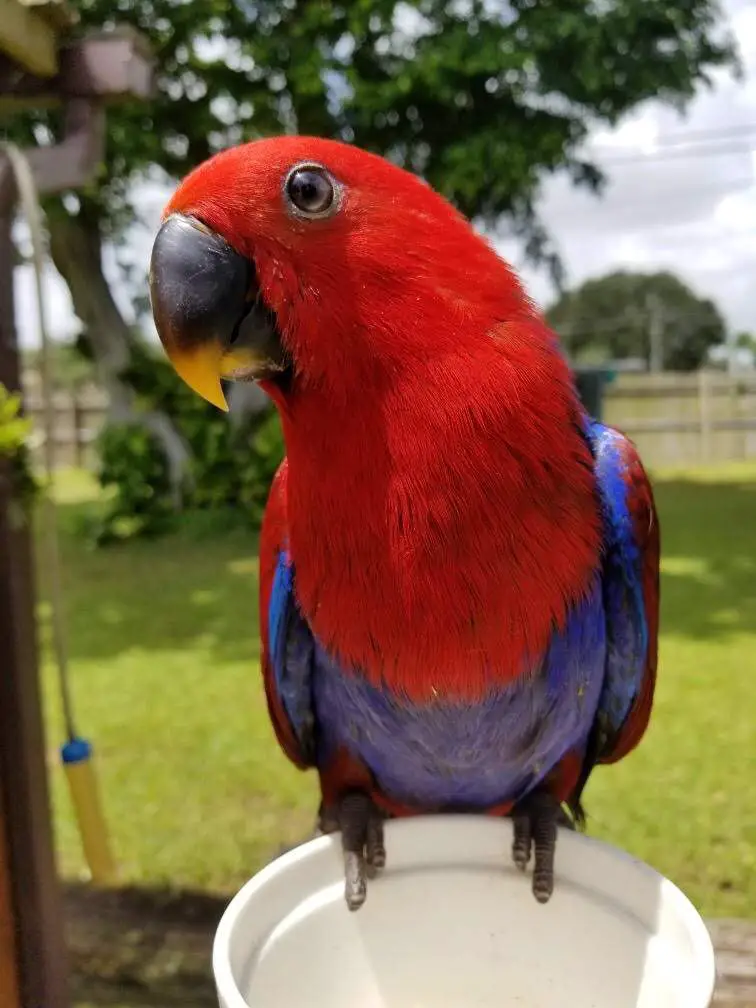
The Eclectus parrots are composed of 9 subspecies, with notable differences for each one. There are four that are most commonly seen in captivity:
- Red-sided Eclectus parrots – They are commonly seen in the mainland of New Guinea and is identifiable with blue eye rings without any yellow tail tips. Scientific name: Eclectus roratus polychloros
- Grand Eclectus parrots – They are commonly seen in the Southern Moluccan Islands, which are also known as the Maluku Islands, Moluccas, and the Spice Islands. Scientific name: Eclectus roratus roratus
- Solomon Island Eclectus parrots – They are native to the Solomon Islands found in the east of New Guinea. Scientific name: Eclectus roratus solomonensis.
- Vos Eclectus parrots or Vosmaeri Eclectus parrots – They are native to the Northern Moluccan Islands and are identifiable with their yellow tail tips and blue eye rings. Scientific name: Eclectus roratus vosmaeri
The subspecies that are a little uncommon to most people are:
- Biaki or Biak Island Eclectus parrots – These are native to the Biak Islands found in the northwest of New Guinea. Scientific name: Eclectus roratus biaki
- Sumba Island Eclectus parrots – Also known as Cornelia’s Eclectus parrots, these subspecies can be found in the Sumba Islands of Indonesia. Scientific name: Eclectus roratus cornelia
- Australian Eclectus parrots – Also known as the Macgillivray Eclectus parrots, these are native to Australia, specifically in the Cape York Peninsula. At an average length of 14.5 inches and 37 cm, this subspecies is the largest out of all the Eclectus parrots. Scientific name: Eclectus rotarus macgillivrayi
- Tanimbar Island Eclectus parrots – These birds are native to the Tanimbar Islands in the Maluku province of Indonesia. These are the smallest out of all Eclectus parrots subspecies with a size of 11.5 inches or 29.25 cm. Scientific name: Eclectus rotarus riedeli
- Aru Island Eclectus parrots – These birds reside in the Aru Islands that are located in the southwest of New Guinea. They are larger than the Red-sided Eclectus parrots and have red eyes. Scientific name: Eclectus rotarus aruensis
- Westerman’s Eclectus parrots – This subspecies is still seen as a doubtfully valid, but it is yet to be unknown. This is identifiable with their average length of 11.5 inches or 29.25 cm.
Availability and Natural Habitat
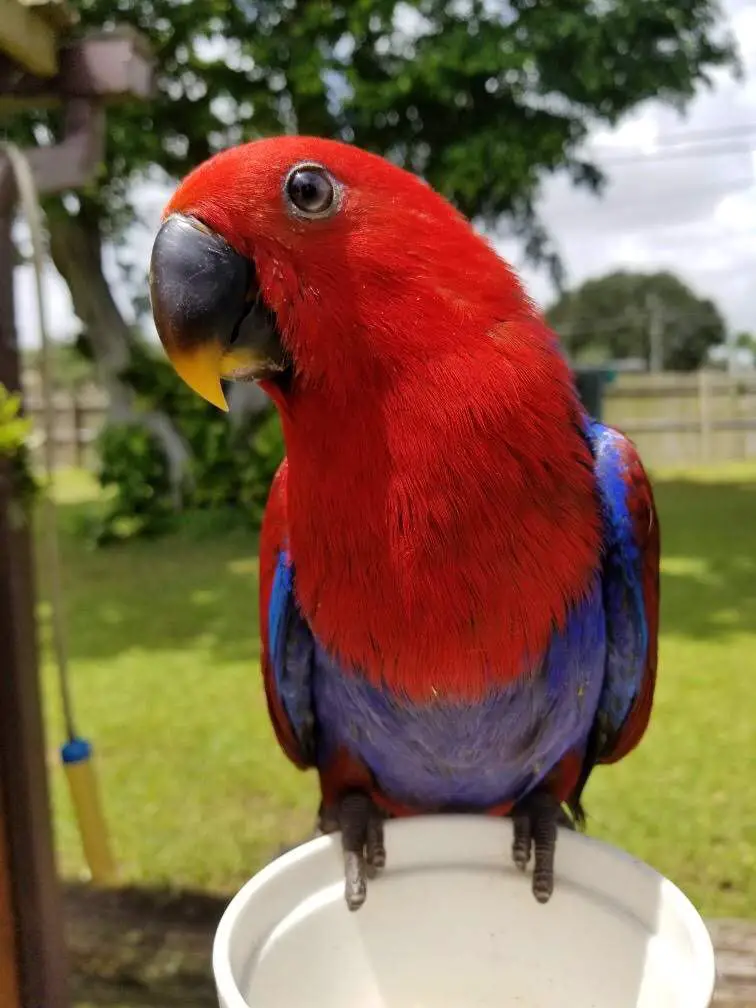
The Eclectus parrots are native to Northern Australia, New Guinea, Indonesia, Solomon Islands, and the Moluccas. Originally, they reside in the rainforests of these locations. In the native monsoon forests, these Eclectus parrots are seen to nest at the top of most trees. Most of the time, they prefer to look for deep nesting holes where they will be able to safely lay their eggs and raise their Eclectus parrot family in peace.
Behavior and Personality
Video Source: https://www.youtube.com/watch?v=aJ8PQ8xqw9Q
Embed Code: <iframe width=”640″ height=”360″ src=”https://www.youtube.com/embed/aJ8PQ8xqw9Q” frameborder=”0″ allow=”accelerometer; autoplay; encrypted-media; gyroscope; picture-in-picture” allowfullscreen></iframe>
Eclectus parrots are gentle birds with sharp brains that are easily loved by humans because of their tranquil nature. They have no problems with the presence of children, but they still have some limits like constant noise disturbances and frantic activity. Therefore, if you have small children in your home, it would be best to teach them how to behave around the Eclectus parrots.
These lovely parrots enjoy establishing a routine in their daily lives. The Eclectus parrots can be taught about the things that they can expect while living in a house, and they enjoy being a part of the simple activities that their human families normally do.
Most of the Eclectus parrots can be kept living in a household with multiple persons and birds, but there are individuals that develop jealous tendencies. This is why when you plan on bringing a new bird to your aviary, make sure that you balance between your time between the individual birds.
Eclectus parrots are also very affectionate and social. They crave attention and are happy spending hours to have fun with their human families. But, in comparison to other birds, they are on the quiet side and do not make too much noise. Eclectus parrots can be taught to speak a few words, and they are fast learners that can catch on almost anything their owners chooses to teach them.
The female Eclectus parrots have strong instincts for nesting, so they are more inclined to seek out some nesting sites in enclosed and dark areas around their homes. Usually, these places can be underneath some furniture or inside some cupboards. Plus, during the breeding season, the female Eclectus parrots can also become quite territorial. So, if they share their space with some males, these females can be bossier to the males.
Though males and females are wonderful pets to keep, many in the bird community agree that the males are a little more agreeable and trainable compared to the females. On the other hand, females are less dependent on their owners and are able to easily handle stressful situations better than their male counterparts. It is well-known that the females are a little too aggressive, especially during the breeding season.
Toe Tapping and Wing Flipping
One of the most famous peculiar behaviors of these birds that have been observed by countless owners is their toe-tapping and wing flipping. Toe-tapping is a condition where their toes repetitively contract and extend.
The possible causes are:
- Ingestion of Foreign Objects – Some Eclectus parrots were examined via X-ray machine and was found to have ingested a part of their toys. After the toys were removed, toe-tapping stopped and resolved itself.
- Fortified Food Items – Some Eclectus parrot owners have linked the problem with pasta, fortified seed mixes, and bird treats. As soon as these food items were removed from the diet of these birds, the toe-tapping behavior also ceased. If your bird enjoys eating pasta, you can switch them for organic corn pasta, which has not been linked to causing this type of problem.
- Pellets – Most pellets contain chemicals like preservatives, food coloring, and artificial dyes. Eclectus parrots have been known to be tolerant of these chemicals for about 2 years, but once a chemical build up develops, symptoms like toe-tapping, wing flipping, feather plucking, and aggression may appear.
Because of this, owners must do the following:
- Remove any food items, whether solid or liquid, that have been introduced to your pet before they started to exhibited symptoms.
- Feed the Eclectus parrots with organically grown food items, about two to three times a day.
- Use distilled water for their hydration.
- Remove any source of chemicals in the environment of your Eclectus parrots. Usually, this involves air fresheners and chemical cleaners.
- Provide extra calcium to your Eclectus parrot’s diet for the next few days. It can be given through baked eggshells that you can crush then sprinkle over moist food or calcium or magnesium supplement from health stores.
Food and Eating Habits
Video Source
Embed: <iframe width=”640″ height=”360″ src=”https://www.youtube.com/embed/1bjXCeCz8NQ” frameborder=”0″ allow=”accelerometer; autoplay; encrypted-media; gyroscope; picture-in-picture” allowfullscreen></iframe>
When in the wild, the Eclectus parrots are mainly comprised of figs, flowers, leaves, buds, seeds, and fruits like papaya and pomegranate. Eclectus parrots have also developed a long digestive tract in comparison to other species of birds. For this reason, some aviculturists believe that they need high fiber and a low-fat diet that is not overly supplemented with vitamins and minerals. With this type of diet, the development of fatty tumors can be avoided, and toxicities from vitamins and minerals can also be escaped.
Generally, Eclectus parrots can benefit from the presence of more fruits and vegetables in their diet, as well as some pelleted food. Many Eclectus parrots recommend that feeding pellets that are free of dyes and artificial colors for a healthier parrot.
Specific dietary requirements of Eclectus parrots:
- Fat – The diet of mature Eclectus parrots must consist of 6 percent of fat. For more active younger birds, their diet must consist of 12 percent of fat
- More fruits and vegetables – The Eclectus parrots must be fed 80 percent soft foods, like thawed and fresh fruits, soaked seeds, and vegetables. They love eating bananas, apples, corn, mango, pear, passion fruit, watermelon, berries, and cantaloupe.
- Vitamin A – The Eclectus parrots often encounter Vitamin A deficiency, and they need to have a diet that is made of dark leafy greens and orange-colored produce. Remember that it is important to get these vitamins from natural sources instead of getting synthetically produced nutrients that may not be absorbable and can be overdosed. Some common foods that are high in Beta Carotene and Vitamin A are:
- Red chilli peppers – Most Eclectus parrots love red peppers, and they are beneficial for being rich in beta-carotene. This includes dried hot peppers that can be found in dried food mixes.
- Broccoli leaves and flowers – Rich sources of beta carotene, including dandelion greens
- Egg yolks – But, the advice is not to offer eggs more than twice a month
- Papaya
- Mango
- Carrots – Juiced or shredded
- Sweet Potatoes
- Spinach
- Cantaloupe
- Turnip leaves
- Collards
- Endive
- Sprouting – Sprouting is a cost-effective method to provide nutrient-dense foods to your pet Eclectus parrots. They are much easier to be accepted by Eclectus parrots because they feel like seeds. They are deemed healthier because of being in lower in fat while providing a nutritious supply of chlorophyll, enzymes, proteins, vitamins, and minerals.
- You can soak and germinate oil seeds like rape seeds and niger seeds, as well as starch seeds like millets and canary.
- Sprouting seeds are great for rearing and weaning foods as their softened shells are easier to break by the chicks, and this can get them used to the overall texture of the seeds they will consume when they grow up.
- High-Quality Dry Food Mix – These are convenient options that lack many of the harmful additives that are commonly found in commercial food mixes and have a great variety of quality ingredients, which include herbs, greens, superfoods, dried fruits, vegetables, and bee pollen.
Exercise
The Eclectus parrots need plenty of room to exercise because they are generally very active. Owners should invest in a bird-safe area in the house where the Eclectus parrots can explore and climb as much as they want. If they can, they must provide a large play stand for this specific need. Having access to proper exercise helps maintain the mental and physical health of these parrots, and it is necessary to keep them happy and healthy.
Owners should provide these birds with perches that are made up of different materials and diameters so that their feet will remain healthy. A good variation of fun toys, swings, and climbing ladders would surely make your pet Eclectus parrots very happy.
If you can provide them with enough stimulation, the Eclectus parrots can do a better job compared to other parrots in terms of being left alone when you have something else to do.
Training
Eclectus parrots are one of the most intelligent species of birds, and they are famous for being great talkers. If their owners do not grab the chance to train them, they can be exposed to many problems like excessive chewing, especially at important stages of their lives.
Many owners have discovered that these birds utilize their beaks as a method of calling out or disciplining their own owners once they have grown up. This is why it is important that owners take time to understand them and guide them so that undesirable behaviors can be dealt with.
Even as a young bird, the owners must be able to exhibit proper guidance. This can be challenging if the bird is exposed to neglect, abuse, and in need of rehabilitation.
Overall, it is important to train the birds to stop these types of parrot behavior:
- Screaming – Eclectus parrots may not be the noisiest parrot species because they are generally known to be quiet and tranquil. But, when they choose to call, these parrots can certainly be heard. In fact, there are times when their calls can be quite deafening and hurtful for the ears. Not everyone can tolerate this type of sound. They may scream when they are startled, scared, or very happy that you have finally come home. If the household is also very noisy, they might scream out of nowhere just to make it seem that they are included in the conversation.
- Biting – Eclectus parrots, just like all types of birds, might be able to discover that their beaks are useful as a method of expressing dissatisfaction, annoyance, or anger. In this species, females tend to do this more than their male counterparts. But, the males are more sensitive to noise, though, so they will exhibit this behavior when they feel too much. It is really important that bird owners take the time to understand their pets and learn to guide their behavior before they develop bratty and undesirable antics. If their aggressive behavior remains unchecked, the female Eclectus parrots are likely to dominate the entire family. They show this by attacking their least favorite humans and competing against birds and humans for the affection of their favorite human.
- Excessive Chewing – Naturally, every parrot loves chewing on anything under the sun. Usually, they make the most of their beaks to customize the barks and branches of their favorite trees. This behavior is good and helpful for maintaining the best condition for their beaks. However, a problem will arise if they chew too much, and if they chew on the wrong items. Therefore, owners must teach their birds the proper items to chew on like toys, branches, and wooden items, instead of other things like wires, metals, and cables.
Breeding
For the Eclectus parrots, the breeding season lasts from July to January. The incubation is done by the female and lasts for about 26 days. To make their nests, the Eclectus parrots digs a big hole that is estimated to be about 50 cm to 6 m within the trunk of a tall tree in a clearing or towards the end of the forest. Then, these birds line their nest using decayed wood dust and some chips.
When the eggs hatch, both parents spend time caring for their young. The young ones leave the nest about 11 to 12 weeks after they have hatched.
Common Health Problems
Eclectus parrots are beautiful pets, but they come with unique dietary needs, and they can be exposed to different kinds of diseases. Here are the main ones to watch out for and how they can be avoided.
- Nutritional Disorders
- Common Symptoms
- Uncharacteristic changes in the colors of the feathers. Color changes are a common sign of nutritional disorders. Color changes may indicate liver problems that are also connected to malnutrition.
- Watch the breast development of the birds. Healthy eclectus should not have large breasts, and the development of meaty breasts are a sign of obesity. If the bird is becoming obese, you should re-evaluate their diets.
- On the other hand, if the bird’s breast bone is very prominent, the bird is underweight and is not receiving enough nutrition or is not being fed enough by their owner.
- Watch out for aggression because aggressive birds might not be receiving the vitamins they need, or they may be feeling hungry.
- Watch out for signs of hyperactivity. If this occurs, consider feeding them fruits and vegetables.
- Look out for the destruction of the bird’s feathers. Birds that tear out their feathers experience an underlying nutritional disorder.
- List of Common Nutritional Disorders
- Hypovitaminosis A – A disorder that Eclectus parrots experience when they do not get enough Vitamin A in their diet. The most common cause of this disease is the overconsumption of seeds. This is a very severe threat to the health of your parrot’s health. Some symptoms include diarrhea, lack of appetite, labored breathing, nasal discharge, feather discolorations, and white patches on the mouth or the tongue.
- Calcium and Phosphorous Imbalances – This also occurs when an eclectus parrot eats too many seeds and grains. This results in the inability to digest and absorb calcium and phosphorous. The symptoms include bone fractures, brittle eggs, osteoporosis, and a general feeling of weakness.
- Vitamin D Imbalances – Like other nutritional imbalances, this reflects on a poor diet of the Eclectus parrots. This also involves the inability to metabolize calcium, therefore, resulting in the formation of kidney stones. The common symptoms include irritability, excessive urination, inability to urinate, and excessive thirst.
- Liver Problems – Some symptoms of digestion-related liver problems are low energy, low appetites, and abnormal colors of feathers. If these are caught early, the liver problems will be resolved. If not, it can lead to endangering your bird’s life or even death.
- Common Symptoms
- Salmonella
- The most common disease among feeder birds is Salmonellosis that is caused by the bacteria Salmonella, and it often starts as an intestinal-tract infection.
- Symptoms are lethargy, diarrhea, and ruffled feathers. But showing symptoms can lead to the bird dying within 1 to 3 days.
- The disease can spread rapidly at feeding stations where the birds eat foods that have been contaminated by the droppings of sick birds.
- This disease can also be transmitted to people who handle sick or dead birds.
- Trichomoniasis
- This is called by a group of one-celled protozoa and regularly affects different types of parrots. This is exhibited by developing sores in the mouth and throats because of the difficulty of swallowing.
- Aspergillosis
- Aspergillosis is a fungal infection that is caused by the Aspergillus fungus, which can usually be found in damp or wet seed mixtures, in landfills, and bird nesting materials.
- When these spores are inhaled, the air sacs of these birds eventually cause bronchitis and pneumonia.
- The symptoms of these illnesses are diarrhea, weakness, wheezing, poorly appearance, and breathing.
- Avian pox
- This is a viral disease has been reported to infect 60 different species of birds, including Eclectus parrots.
- The symptoms of this disease are lesions that form on unfeathered parts of the body like eyelids, feet, and legs. Lesions also form in the mouth and around the mouth.
- In isolated cases, if the lesions are seen toward their eyes, the birds might have trouble locating their food, but most birds recover from the virus.
- The virus can be spread by having direct contact with infected birds at the feeders or through bites of mosquitoes that have fed on the blood of sick birds.
- Lice and mites
- Some species of lice and mites subsist on skin and bird feathers while others suck blood.
- They can cause anemia, or in worse cases, death in young birds.
- The most common symptoms of feather mites in birds are having featherless and bald heads.
- Avian Gastric Yeast (AGY) Infection or Wasting Disease
- This disease is also known as megabacteriosis and macrorhabdiosis.
- It is a mixture of a yeast infection and a secondary bacterial infection.
- This disease is difficult to spot in its early stages, and it does not show any ounce of trouble.
- The first outward sign is weight loss, as this disease can impede digestion.
- Candidiosis
- This disease is also considered as a yeast infection and can even infect some humans.
- This disease blooms in the crop of the parrot and their digestive tract. It can be transmitted to humans if you decide to kiss your pet.
- If your bird is infected, it will show signs of being listless, and it will also have some loose droppings.
- For diagnosis, a consultation with a veterinarian is required.
- Colds and Sneezes
- Colds and sneezes are some of the most common diseases for Eclectus parrots.
- The symptoms are very similar to humans and are shown through sneezing, wheezing, swollen eyes, and runny noses.
- Though this parrots are easy to get, this condition can lead to a rapid decline without the administration will be required.
- Psittacosis
- Commonly known as parrot fever, this can be the worst thing that can strike your pet Eclectus parrots. This disease spreads very quickly, and most of the affected individuals will die.
- The best way to prevent this problem is to keep a clean cage or birdhouse. If the infection strikes, the quickest way is to disinfect the environment by seeking for suitable treatments that are readily available to veterinarians.
- For infected Eclectus parrots, quarantine of at least 45 days is essential.
Environment and Housing
For the housing of the Eclectus parrots, most experts suggest that the measurements be a cage size of 24 inches by 36 inches by 48 inches. However, owners can consider something even bigger because Eclectus parrots need plenty of room to climb, play, and survive. Owners should also make sure that the cage bar spacing is at list 0.75 inches to 1.5 inches. The perch diameter should also measure approximately 1 inch. Additionally, if your Eclectus parrots will not always be exposed to natural light, you should consider offering them a full spectrum light so that they will not be prone to developing Vitamin D deficiency.
Fun Facts about the Eclectus Parrots
- Male Eclectus parrots are so different than females in terms of visual qualities that ornithologists once believed they were two separate species of parrot.
- Eclectus parrots come in an assortment of sub-species, including the Grand Eclectus, the Vosmaeri, and the Solomon Island Eclectus parrot.
Where Can You Get a Pet Eclectus Parrot?
If you want to keep Eclectus parrots as your pets, you can usually get one from avian specialty shops or from bird breeders. You should also be careful that are you are acquiring a purebred and not a hybrid. This is because some breeders cross different subspecies of the Eclectus parrots resulting in a mutt Eclectus parrots. Though this will not change the overall quality of your Eclectus parrot, the mixed genes can have the chance to potentially contaminate the bird’s species.
Though gene contamination may not be important for you as an owner, it is important to preserve a pure gene pool, because it is important to continue this species for the generations to come.
How to Care for a Pet Eclectus Parrot?
Video URL
Embed: <iframe width=”640″ height=”360″ src=”https://www.youtube.com/embed/H74CeYrS-oI” frameborder=”0″ allow=”accelerometer; autoplay; encrypted-media; gyroscope; picture-in-picture” allowfullscreen></iframe>
Eclectus parrots are high in activity, so the owners must be able to provide these pets with a spacious cage plus including lots of their time playing outside of their cage. Therefore, owners must get the largest rectangular birdcage that they can afford because the Eclectus parrots can become unhappy and quite restless when they feel that their space is confined.
Eclectus parrots are also playful in nature, which is why the owners must be able to provide a multitude of toys that are designed to be chewed and destroyed, including those toys that are made of softwood. Owners must also make sure that the Eclectus parrots will receive lots of love and attention. Eclectus parrots can keep themselves busy on their own, but their owners must also be able to provide their birds with some stimulating objects to give them little jobs that they can work on.
Frequently Asked Questions
How much do Eclectus parrots cost?
The Eclectus parrots can be priced at 2,000 dollars per individual. Some can be priced as low as 1,500 dollars, but they can also be as high as 2,500 dollars.
Do Eclectus parrots make good pets?
Eclectus parrots can make great pets are eye-catching, charming, intelligent, and they make impressive pets. They have beautiful colors, lovable personalities, and surprising talking abilities.
What is special and unique about the Eclectus parrots?
The special thing about Eclectus parrots is that they have feathers that look like fur.
Are Eclectus parrots good for beginner bird owners?
The Eclectus parrots are great for first-time parrot owners because of their ability to adapt well in captivity, and they are easy to care for compared to other species of parrots.
Are Eclectus parrots loud?
The Eclectus parrots are not as loud as their other parrot cousins. They have a very natural call that can be loud when needed be.
Are Eclectus parrots cuddly?
Eclectus parrots can be very affectionate to their owners, especially with their favorites.
Do Eclectus parrots talk?
Eclectus parrots actually rank among the best parrots in terms of their talking abilities. They have a great scope of vocabulary and clarity of their speech.
Can Eclectus parrots eat bananas?
Eclectus parrots can eat bananas and make it a part of their regular diet.
At what age do Eclectus parrots start talking?
Eclectus parrots start talking when they reach 4 months of age, but others wait until they are one year old.
How long does an Eclectus parrot live?
The average lifespan of Eclectus parrots are set at 30 years, but it can reach up to 50 years.

